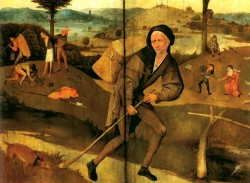
Tuttle 1981
“Bosch’s Image of Poverty” (Virginia G. Tuttle) 1981
[in: Art Bulletin, vol. LXIII, nr. 1 (March 1981), pp. 88-95]
[Also mentioned in Gibson 1983: 123 (E289)]
The American art historian Virginia G. Tuttle begins her article with the observation that the landscape in the exterior panels of the Haywain triptych is filled with details referring to Evil. Then she relates the ragged man walking through this landscape to fourteenth-century Italian frescos, particularly to Franciscan virtue cycles. In these frescos the idea of voluntary poverty is represented allegorically by a ragged figure (mostly female, sometimes male) that is attacked by a growling dog (a symbol of Christ’s tormentors). This ideal of voluntary poverty is also a major theme in early Franciscan literature: here poverty is considered the most secure bulwark against the sins of the flesh, particularly avarice, and as a way to imitate Christ.
The protagonists in the exterior panels of the Haywain and in the Rotterdam tondo do indeed show a certain similarity to one of the visual sources discussed by Tuttle (a fresco in the Baroncelli Chapel of the S. Croce in Firenze). Tuttle suggests that Bosch knew this fresco from a model book that circulated in the Netherlands and thus influenced early Dutch imagery. She also points out that Franciscan ideals were widespread in the fifteenth-century Netherlands and that they had much in common with the ideas of the Devotio Moderna. According to Tuttle the protagonist of Bosch’s exterior panels represents voluntary poverty. This protagonist is a solitary, afflicted man, a Christ-like sufferer in a hostile, sinful world. Bosch painted him in the exterior panels of the Haywain triptych because voluntary poverty was considered the best remedy against the temptations of the flesh, particularly against avarice and also against unchastity and it are these deadly sins that are being depicted in the central panel. In the Rotterdam tondo Bosch painted a similar figure but because of a number of symbolic details this ragged figure should be interpreted as a symbol of ‘involuntary poverty’: this poverty is a punishment for those who squander their possessions in a sinful and foolish way. Tuttle relates the protagonist’s hat, the ‘sore’ on his bandaged leg, his ‘lost’ shoe, his purse, the awl, the little hoof and the catskin to different kinds of sins and vices.
A lot can be said in favour of the association of the protagonist in the Haywain’s exterior panels with the ideas of voluntary poverty and imitation of Christ. But this deals with only one aspect of this allegorical figure and thus Tuttle’s final conclusion about the iconography of the exterior panels seems rather limited. Furthermore, she makes an unnecessary detour by deriving this interpretation from fourteenth-century Franciscan literature and iconography: as is pointed out by the author herself, these ideas were largely shared by the fifteenth-century movement of the Modern Devotion. Why would Bosch have looked for inspiration in another century and in another country when he could find it in his immediate, contemporary environment? Moreover, Tuttle inconsiderately ignores the fact that the (within her argument exclusively Franciscan) ‘poor tramp attacked by dog’ motif was a late-medieval topos that does not always have to be related to the idea of voluntary poverty.
Tuttle’s analyses shows three further methodological weaknesses. First: her interpretations of the exterior panels of the Haywain and of the Rotterdam tondo contradict each other: in the former case the protagonist is positive, in the latter he is negative. Taking into account the numerous visual parallels it is far more obvious to interpret both protagonists in the same iconographic way. A second weakness is that Tuttle explicitly refuses to interpret both protagonists as pedlars. Because of this the essential allegorical meaning of these figures largely escapes her. Finally, it is also little convincing that she does not analyze all details of the Rotterdam tondo and that some details of the tondo are described in a wrong way: the great tit is said to be a magpie, the bandage on the pedlar’s left leg is said to hide a sore.
[explicit 2000]